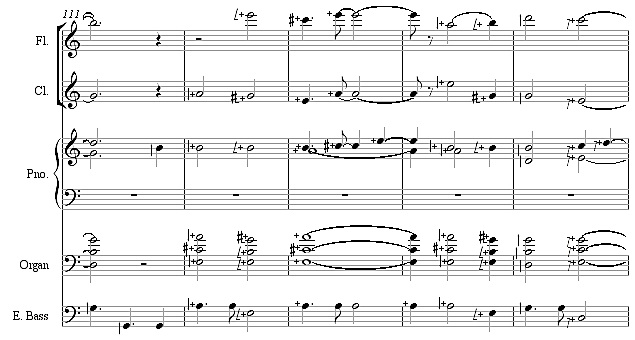Awhile back my Australian composer friend Andrian Pertout – I should say, one of my multitudinous Australian composer friends – e-mailed me a font for Ben Johnston’s microtonal pitch notation. I’m not very good at this kind of technological challenge, and we had been down this road before, so I filed it away to deal with later. But being in between compositions this week and without any particular idea in my head, I tried it out and got it to work! What this means is that now, for the first time, I can notate my microtonal music on the computer with the correct notation. Until now, all my microtonal pieces have had to be hand-written scores, or else with some jerry-rigged notation showing cents sharp or flat, and so on. But I got inspired – or rather, remained uninspired, and thus in need of some mind-numbing busywork project – and renotated my piece The Day Revisited in Ben’s beautiful notation. I’m very excited about it.
It took me something like 14 hours to place all the accidentals in a 13-minute quintet. You can see a sample here:

And if you want, you can download the entire score here. The little sevens in Ben’s notation lower notes to make them 7th harmonics, and the upside-down sevens raise them the same amount. The upward arrows (which I hope you can see at least on the PDF; they’re undeniably faint here) raise a pitch a quarter-tone to make it an 11th harmonic, and down-arrows lower the same amount. The pluses correct for the syntonic comma, and if that’s Greek to you, well, sonny, you’ll understand when you get older. But enough about that. The important thing is that now I have a downloadable copy of The Day Revisited which, even if you don’t understand the notation, reveals much more about how the piece works than the old cents-sharp-or-flat score does. And if it took 14 hours, that’s a shorter job, and a less exhausting one, than it would have been to copy the score by hand, which I once assayed to do and gave up.
Andrian uses Finale; I use Sibelius. (O when, o when, will these Finale users see the light and bend to the inevitable?) He says the font is more convenient in Finale, where it can be programmed to punch in next to a note like a regular accidental. In Sibelius, I had to treat it like text (apple-T) and painstakingly drag each accidental next to the note. But I’m impressed with the way it looks, at least on my print-out; I’d be curious to hear others’ results. He’s not quite ready to go public with the font yet. Meanwhile, a recording of The Day Revisited, which will be released in September on my CD Private Dances from New Albion, is still on my web site for now, where you can listen to it here and compare it with the score, if that kind of thing appeals to you. I think, and have been told, that it’s my most ear-opening microtonal work yet.
I fantasize that, on my deathbed, someone is going to run in with the news that a new software has been developed that will not only notate Ben’s pitch notation with seamless ease, but play it back in incredible acoustic fidelity. Someone like Alex Ross, or Michael Gordon, or one of those guys (they’ll all be there) will turn to me and jeer, “Seems you were born at precisely the wrong time, Gann: late enough to find just intonation irresistible, but too early to find it feasible!” The pained expression with which I depart this vale of tears will have nothing to do with my final illness, I assure you.
